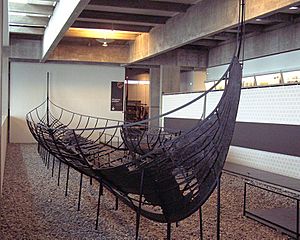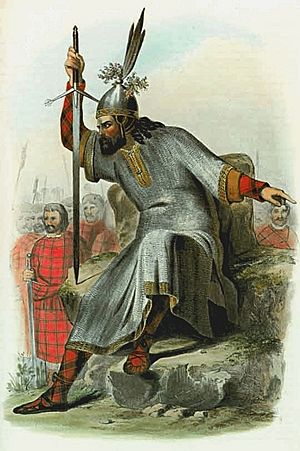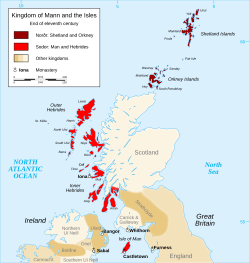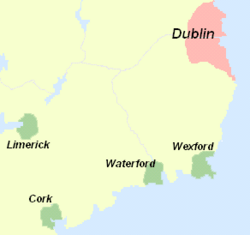Norse–Gaels facts for kids
The Norse–Gaels were a unique group of people with mixed Gaelic and Norse (Viking) backgrounds. Their name, Gall-Goídil, means "foreigner-Gaels." They appeared during the Viking Age when Vikings settled in Ireland and Scotland. These Vikings started to adopt Gaelic customs and language, and they married local Gaels.
From the 800s to the 1100s, the Norse–Gaels controlled much of the Irish Sea and Scottish Sea areas. They created important kingdoms like the Kingdom of the Isles (which included the Hebrides and the Isle of Man) and the Kingdom of Dublin. They also founded the Lordship of Galloway (named after them) and even ruled the Kingdom of York for a short time. The most powerful Norse–Gaelic family was called the Uí Ímair, or the House of Ivar.
Over time, the Norse–Gaels became more and more Gaelic. They eventually blended in and were no longer a separate group. However, they left a big mark, especially on the Isle of Man and the Outer Hebrides. Many place names there still come from Norse–Gaelic words. Several Scottish clans, like Clan MacDonald, Clan MacDougall, and Clan MacLeod, have Norse–Gaelic roots. The famous mercenary warriors called the gallowglass also came from these clans. They were very important in Irish battles. Even the Viking longship influenced Gaelic boats like the birlinn or longa fada, which were used until the 1600s. Some Norse–Gaelic surnames are still around today, such as Doyle, MacIvor, MacAskill, and (Mac)Cotter.
Contents
Understanding the Name "Norse–Gaels"
The term Gall-Goídil means "foreigner Gaels." It was used to describe Gaelic-speaking people who also had some Norse (Viking) identity. This name changed a bit over time and in different places where Gaelic was spoken. For example, it could be Gall Gaidel, Gall Gaidhel, or Gall Gaedhil. Today, in Irish, it's Gall-Ghaeil, and in Scottish Gaelic, it's Gall-Ghàidheil.
The Norse–Gaels often called themselves Ostmen or Austmen, which means "East-men." This name is still seen today in the Dublin area called Oxmantown. This name comes from Austmanna-tún, meaning "homestead of the Eastmen." In contrast, they called the native Gaels Vestmenn (West-men). You can still see this in names like Vestmannaeyjar (Westman Islands) and Vestmanna.
Other names for the Norse–Gaels include Norse-Irish or Hiberno-Norse for those in Ireland. For those in Scotland, they were sometimes called Norse-Scots or Scoto-Norse.
The History of the Norse–Gaels


The Norse–Gaels first appeared in the Viking settlements of Ireland and Scotland. They were the children of Norse immigrants and native Gaels who married each other. As early as the 800s, many Norse settlers (except those in Cumbria) married Gaels. They started speaking the Gaelic language and adopted many Gaelic customs. Many also stopped worshipping the Norse gods and became Christian. This helped them become more Gaelic.
These Gaelicised Scandinavians were very powerful in the Irish Sea region until the Norman era in the 1100s. They created long-lasting kingdoms, such as the Kingdoms of Man, Dublin, and Galloway. They also took control of the Norse settlement at York.
Norse–Gaels in Ireland
The first record of Vikings in Ireland is from 795 AD, when they attacked Lambay Island. They continued to raid occasionally until 832 AD. After that, they began to build strong, fortified settlements across the country. Viking raids continued through the 900s, but the Irish fought back more and more.
The Norse established independent kingdoms in important towns like Dublin, Waterford, Wexford, Cork, and Limerick. These kingdoms did not survive the later Norman invasions, but the towns themselves continued to grow and thrive.
Between the 1100s and 1300s, the English in Ireland used the term Ostmen to describe the Norse–Gaelic people living there. This word literally means "men from the east" (meaning Scandinavia). The Ostmen were seen as a separate group from the English and Irish. They had special rights and privileges that the Irish did not.
They lived in their own areas. In Dublin, they lived outside the city walls on the north side of the River Liffey in a place called Ostmentown. This name still exists today as Oxmantown. Other groups of Ostmen lived in Limerick and Waterford. Many were merchants, while others fished, made crafts, or raised cattle. Their role in Ireland's economy made them valuable, and the English Crown gave them special legal protections. These protections eventually faded as the Ostmen blended into the English settler community during the 1200s and 1300s.
Norse–Gaels in Scotland
The Lords of the Isles were powerful rulers whose influence lasted until the 1500s. Many other Gaelic rulers in Scotland and Ireland traced their family lines back to Norse–Gaelic settlements in northwest Scotland, especially in the Hebrides.
Even today, the Hebrides are known in Scottish Gaelic as Innse Gall, which means "the islands of foreigners." It's interesting because these islands are now one of the last places where Gaelic is strongly spoken in Scotland.
The MacLachlan clan name means "son of the Lakeland," which is thought to refer to Norway. Their Scottish clan home is on the eastern side of Loch Fyne. This name and its variations are common from this part of Scotland all the way to Donegal in Ireland.
Norse–Gaels in Iceland and the Faroes
Ancient texts, like the Landnámabók, say that there were papar (Gaelic monks) in Iceland before the Norse arrived. This matches what a writer named Dicuil said and is supported by recent archaeological finds. When the Norse settled Iceland and the Faroe Islands, many Norse–Gael settlers, as well as slaves and servants, came with them. They were called Vestmen (Western men). This name is still used in Vestmanna in the Faroes and the Vestmannaeyjar islands off Iceland.
Some Icelandic personal names come from Gaelic, such as Njáll, Brjánn, Kjartan, and Kormákur. These come from the Gaelic names Niall, Brian, Muircheartach, and Cormac. An Icelandic village, Patreksfjörður, is even named after Saint Patrick. Many places in Iceland and the Faroes are named after the papar.
There is some evidence that Grímur Kamban, who is seen as the first Norse settler in the Faroe Islands, might have been a Norse Gael. The Faereyinga Saga says he was the first to settle the Faroes. His nickname, Kamban, is likely Gaelic. It might mean he had a physical handicap (from the Old Gaelic camb, meaning crooked). Or, it could mean he was good at sports, possibly a game like hurling (camóige). It's thought he came to the Faroe Islands as a young man through Viking Ireland. Local stories say he settled at Funningur in Eysturoy.
Norse–Gaelic Influence on Names and Words
Even today, many surnames, especially in Gaelic areas like the Hebrides and the Isle of Man, come from Old Norse. Several Old Norse words also influenced modern Scots English and Scottish Gaelic. For example, the word bairn (child) comes from the Norse barn, which is still used in Denmark, Norway, Sweden, and Iceland.
Common Surnames with Norse Roots
| Gaelic Form | Anglicised Form | From Norse Name |
|---|---|---|
| Mac Asgaill | MacAskill, McCaskill | Áskell |
| Mac Amhlaibh | MacAulay, MacAuliffe, Cowley | Óláf |
| Mac Corcadail | McCorquodale, Corkill | Þorketill |
| Mac Coitir | Cotter, MacCotter | Óttar |
| Mac DubhGhaill, Ó DubhGhaill | Doyle, McDowell, MacDougal | Dubgall |
| Mac Ìomhair | MacIver, MacIvor | Ívar |
| Mac Raghnall | Crellin, Crennel | Rögnvald |
| Mac Shitrig | MacKitrick, McKittrick | Sigtrygg |
| Mac Leòid | MacLeod | Ljótr |
Popular Forenames with Norse Roots
| Gaelic Form | Anglicised Form | Norse Equivalent |
|---|---|---|
| Amhlaibh | Aulay (Olaf) | Ólaf |
| Goraidh | Gorrie (Godfrey), Orree (Isle of Man) | Godfrið |
| Ìomhar | Ivor | Ívar (Ingvar) |
| Raghnall | Ranald (Ronald, Reginald) | Rögnvald |
| Somhairle | Sorley (or Samuel) | Sumarliði (Somerled) |
| Tormod | Norman | Þormóð |
| Torcuil | Torquil | Torkill, Þorketill |
See Also



